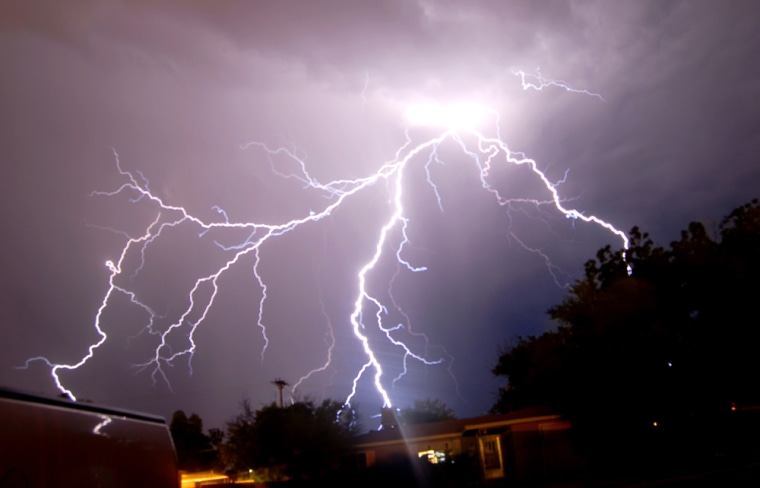Noise phobiasIt's unknown why some pets become afraid of noise. It is a common problem in dogs, but less so in cats. In the case of thunder and lightning, pets can be fearful of storm-related events, like changes in barometric pressure, electrostatic disturbances and even smells associated with storms. Noise phobias can include fear of thunderstorms, firecrackers, gunshots, even the sound of birds.

Certain breeds tend to have a greater phobia of noises, including working and sporting breeds like collies, German shepherds, beagles and basset hounds.
A noise phobia may be traced to a bad experience with a particular noise, but often no triggering event can be determined. In most instances, the fear of noises and storms escalates, worsening with each exposure — the pet may become fearful of similar sounds or events associated with that noise. For example, a pet afraid of thunder may also become afraid of rain.
The owner's attitude can influence the severity of the fear. For instance, if owners themselves are nervous during storms, noise phobias in their pets may occur more often or become more severe. Similarly, if the owner attempts to comfort the animal, the animal interprets it as confirming there really is something to be afraid of. The petting or comforting is really positive reinforcement of an undesirable behavior.
Signs to look out forThere may be a genetic predisposition to certain phobias; for example, some herding and guarding breeds tend to be more likely to suffer from storm phobias since they have been bred to be highly sensitive to sound. Other signs are:
- Shaking and trembling
- Excessive drooling
- Barking or howling
- Trying to hide or get into/out of the house, fence or other enclosure
- Refusing food
- Losing bladder or bowel control or experiencing temporary diarrhea from prolonged stress
- Exhibiting hyperactive behavior or becoming timid
Help for noise phobia
1. Crate: The way to address a noise phobia is to create a calm and safe environment indoors. This is important because some pets become so upset, they could actually hurt themselves and/or escape. A crate can be a great safety net for a dog, especially if he associates it with great things like his meals and special treats. You can cover the crate with a blanket to increase the feeling of security. The door to the crate should be open so the pet does not feel confined inside.
2. Pills: Over-the-counter products such as Content-Eze may also help. This contains tryptophan, which is the amino acid in turkey that makes us feel relaxed after eating it.
3. Tapes of thunderstorms: In some cases, desensitizing a dog to some of the stimuli associated with storms can help. There are tapes of thunder that you can play at a very low level and gradually increase when the dog is doing things he likes, such as eating. This technique requires time and patience, so be sure to go slowly and in short sessions. Make sure you play the sound at a low volume so it will not induce fear.
Home-alone phobiaThe fear of being left alone is another common problem with dogs. Unfortunately, most have to be left alone for long periods of the day while we go to work, so it is important to prevent or resolve this problem as soon as possible. Dogs who have this fear develop separation anxiety — they can panic and show behavioral problems every time the owner leaves. This can cause tremendous emotional distress for both dogs and owners. It can occur in dogs of any age or breed.
Signs to look out for:
- Barking too much, whining, howling
- Escaping from the home
- Hyperactivity, scratching, chewing, digging
- Relieving themselves in the house
- Some dogs end up following their owner from room to room, while other dogs who can tolerate being alone will check in frequently to make sure their owner is still at home.
- Dogs with have separation anxiety will often be overly excited when their owner returns home. They may whine, jump or run in circles. This behavior may go on for an abnormal length of time after the owner gets home.
- Destructive behavior
- Scratching at door and window
Help for home-alone phobia
1. Practice what you want: You have to teach your dog to spend time alone when you are home before you can expect him to do so when you aren't. Rest periods in his crate with food-stuffed toys are a great idea, so the dog gets used to his security area.
2. Don't reward demands for attention: Try not to interact with your dog when he demands attention.
3. Give your dog a job to do — give him physical or mental exercises: For example, play fetch, or hide food-stuffed toys around the house so he is busy hunting for them.
4. Set the right tone: Keep departures and arrivals as low-key as possible. Don't be overly attentive when you leave.
5. Behavior modification: Your veterinarian may be able to give you help with the behavior-modification exercises, or refer you to an experienced animal behaviorist or trainer in your area. Behavior modification exercises must be done consistently (for weeks to months) to see results, and the exercises may need to be continued for life.